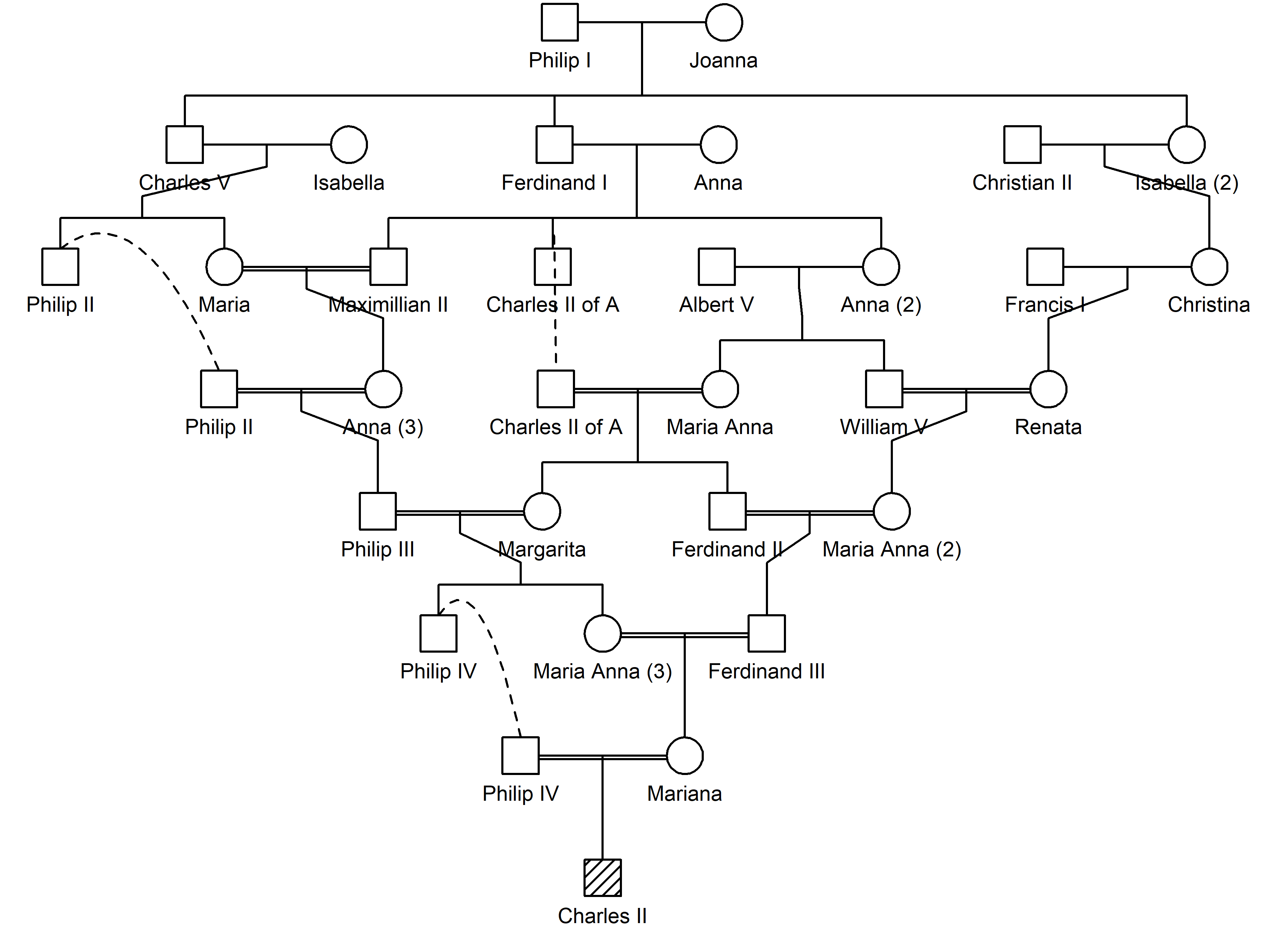The purpose of verbalisr is to describe pedigree relationships in plain language. This is often helpful in order to understand complex genealogies. Given two members of any pedigree, verbalisr spells out the connecting paths between them, using common terminology like great-grandmother and half first cousins.
To see verbalisr in action, check out the interactive app QuickPed for building and analysing pedigrees, available online here: https://magnusdv.shinyapps.io/quickped.
The verbalisr package is part of the ped suite framework for pedigree analysis in R.
To get the current official version of verbalisr, install from CRAN as follows:
Alternatively, the development version can be installed from GitHub:
Here is an example involving a double-cousin-like relationship:
x = doubleCousins(degree1 = 1, removal1 = 1, half1 = TRUE, # half first cousins once removed
degree2 = 2, removal2 = 0) # second cousins
plot(x, hatched = 16:17)
We apply verbalise() to describe the relationship between the children:
verbalise(x, ids = 16:17)
#> Half first cousins once removed
#> 16-10-[4]-12-15-17
#> Second cousins
#> 16-13-6-[1,2]-8-14-17This output shows that 16 and 17 are simultaneous first cousins once removed and second cousins. Below each description follows the corresponding path, with its top-most shared ancestor(s) indicated in brackets. The first path has one ancestor on top, [4], indicating a half relationship, while the second has two ancestors on top, [1,2], contributing a full relationship.
The figure below shows a subset of the (infamously inbred) royal Habsburg family, contained in the built-in dataset habsburg. Untangling all the loops in this pedigree by hand would be a daunting task, making it a good test case for verbalisr.

The inbreeding coefficient of King Charles II of Spain (the bottom individual) has been estimated to be around 25%, i.e., similar to a child produced by brother-sister incest. We can validate this with the ribd package, which provides the function inbreeding():
(The answer is a bit less than 25% since we are only looking at a subset of the historic family tree.)
The high inbreeding coefficient shows that the parents of Charles II were closely related. But how were they related? verbalisr gives the answer:
verbalise(habsburg, ids = c("Philip IV", "Mariana"))
#> Avuncular: Philip IV is an uncle of Mariana
#> Philip IV-[Philip III,Margarita]-Maria Anna (3)-Mariana
#> First cousins once removed
#> Philip IV-Margarita-[Charles II of A,Maria Anna]-Ferdinand II-Ferdinand III-Mariana
#> Second cousins once removed
#> Philip IV-Margarita-Maria Anna-[Albert V,Anna (2)]-William V-Maria Anna (2)-Ferdinand III-Mariana
#> Triple second cousins twice removed
#> Philip IV-Margarita-Charles II of A-[Ferdinand I,Anna]-Maximillian II-Anna (3)-Philip III-Maria Anna (3)-Mariana
#> Philip IV-Margarita-Charles II of A-[Ferdinand I,Anna]-Anna (2)-Maria Anna-Ferdinand II-Ferdinand III-Mariana
#> Philip IV-Margarita-Charles II of A-[Ferdinand I,Anna]-Anna (2)-William V-Maria Anna (2)-Ferdinand III-Mariana
#> Triple third cousins
#> Philip IV-Philip III-Anna (3)-Maximillian II-[Ferdinand I,Anna]-Charles II of A-Margarita-Maria Anna (3)-Mariana
#> Philip IV-Philip III-Anna (3)-Maximillian II-[Ferdinand I,Anna]-Charles II of A-Ferdinand II-Ferdinand III-Mariana
#> Philip IV-Margarita-Maria Anna-Anna (2)-[Ferdinand I,Anna]-Charles II of A-Ferdinand II-Ferdinand III-Mariana
#> Septuple third cousins once removed
#> Philip IV-Philip III-Philip II-Charles V-[Philip I,Joanna]-Ferdinand I-Charles II of A-Margarita-Maria Anna (3)-Mariana
#> Philip IV-Philip III-Philip II-Charles V-[Philip I,Joanna]-Ferdinand I-Charles II of A-Ferdinand II-Ferdinand III-Mariana
#> Philip IV-Margarita-Charles II of A-Ferdinand I-[Philip I,Joanna]-Charles V-Philip II-Philip III-Maria Anna (3)-Mariana
#> Philip IV-Philip III-Anna (3)-Maximillian II-[Ferdinand I,Anna]-Anna (2)-Maria Anna-Margarita-Maria Anna (3)-Mariana
#> Philip IV-Philip III-Anna (3)-Maximillian II-[Ferdinand I,Anna]-Anna (2)-Maria Anna-Ferdinand II-Ferdinand III-Mariana
#> Philip IV-Philip III-Anna (3)-Maximillian II-[Ferdinand I,Anna]-Anna (2)-William V-Maria Anna (2)-Ferdinand III-Mariana
#> Philip IV-Margarita-Maria Anna-Anna (2)-[Ferdinand I,Anna]-Maximillian II-Anna (3)-Philip III-Maria Anna (3)-Mariana
#> Sextuple third cousins twice removed
#> Philip IV-Philip III-Philip II-Charles V-[Philip I,Joanna]-Ferdinand I-Anna (2)-Maria Anna-Margarita-Maria Anna (3)-Mariana
#> Philip IV-Philip III-Philip II-Charles V-[Philip I,Joanna]-Ferdinand I-Anna (2)-Maria Anna-Ferdinand II-Ferdinand III-Mariana
#> Philip IV-Philip III-Philip II-Charles V-[Philip I,Joanna]-Ferdinand I-Anna (2)-William V-Maria Anna (2)-Ferdinand III-Mariana
#> Philip IV-Philip III-Philip II-Charles V-[Philip I,Joanna]-Isabella (2)-Christina-Renata-Maria Anna (2)-Ferdinand III-Mariana
#> Philip IV-Margarita-Charles II of A-Ferdinand I-[Philip I,Joanna]-Charles V-Maria-Anna (3)-Philip III-Maria Anna (3)-Mariana
#> Philip IV-Margarita-Charles II of A-Ferdinand I-[Philip I,Joanna]-Isabella (2)-Christina-Renata-Maria Anna (2)-Ferdinand III-Mariana
#> Triple 4'th cousins
#> Philip IV-Philip III-Anna (3)-Maria-Charles V-[Philip I,Joanna]-Ferdinand I-Charles II of A-Margarita-Maria Anna (3)-Mariana
#> Philip IV-Philip III-Anna (3)-Maria-Charles V-[Philip I,Joanna]-Ferdinand I-Charles II of A-Ferdinand II-Ferdinand III-Mariana
#> Philip IV-Margarita-Maria Anna-Anna (2)-Ferdinand I-[Philip I,Joanna]-Charles V-Philip II-Philip III-Maria Anna (3)-Mariana
#> Septuple 4'th cousins once removed
#> Philip IV-Philip III-Anna (3)-Maria-Charles V-[Philip I,Joanna]-Ferdinand I-Anna (2)-Maria Anna-Margarita-Maria Anna (3)-Mariana
#> Philip IV-Philip III-Anna (3)-Maria-Charles V-[Philip I,Joanna]-Ferdinand I-Anna (2)-Maria Anna-Ferdinand II-Ferdinand III-Mariana
#> Philip IV-Philip III-Anna (3)-Maria-Charles V-[Philip I,Joanna]-Ferdinand I-Anna (2)-William V-Maria Anna (2)-Ferdinand III-Mariana
#> Philip IV-Philip III-Anna (3)-Maria-Charles V-[Philip I,Joanna]-Isabella (2)-Christina-Renata-Maria Anna (2)-Ferdinand III-Mariana
#> Philip IV-Philip III-Anna (3)-Maximillian II-Ferdinand I-[Philip I,Joanna]-Isabella (2)-Christina-Renata-Maria Anna (2)-Ferdinand III-Mariana
#> Philip IV-Margarita-Maria Anna-Anna (2)-Ferdinand I-[Philip I,Joanna]-Charles V-Maria-Anna (3)-Philip III-Maria Anna (3)-Mariana
#> Philip IV-Margarita-Maria Anna-Anna (2)-Ferdinand I-[Philip I,Joanna]-Isabella (2)-Christina-Renata-Maria Anna (2)-Ferdinand III-MarianaThe output of verbalise() is actually a detailed list containing various data about each pedigree path. When the output is printed to the screen, however, a special print method is called, which formats the data into reader-friendly statements.
The print method accepts two arguments, cap and includePaths, which can be used to control the output. Setting cap to FALSE results in all-lowercase output, instead of the default first-letter capitalisation. If includePaths is set to FALSE, the detailed paths are skipped:
v = verbalise(habsburg, ids = c("Philip IV", "Mariana"))
print(v, cap = FALSE, includePaths = FALSE)
#> avuncular: Philip IV is an uncle of Mariana
#> first cousins once removed
#> second cousins once removed
#> triple second cousins twice removed
#> triple third cousins
#> septuple third cousins once removed
#> sextuple third cousins twice removed
#> triple 4'th cousins
#> septuple 4'th cousins once removed